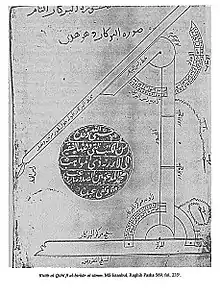Abū Sahl al-Qūhī
Abū Sahl Wayjan ibn Rustam al-Qūhī (al-Kūhī; Persian: ابوسهل بیژن کوهی Abusahl Bijan-e Koohi) was a Persian[1][2] mathematician, physicist and astronomer. He was from Kuh (or Quh), an area in Tabaristan, Amol, and flourished in Baghdad in the 10th century. He is considered one of the greatest Muslim geometers, with many mathematical and astronomical writings ascribed to him.[3][4][5]

Al-Qūhī was the leader of the astronomers working in 988 AD at the observatory built by the Buwayhid amir Sharaf al-Dawla in Badhdad. He wrote a treatise on the astrolabe in which he solves a number of difficult geometric problems.
In mathematics he devoted his attention to those Archimedean and Apollonian problems leading to equations higher than the second degree. He solved some of them and discussed the conditions of solvability. For example, he was able to solve the problem of inscribing an equilateral pentagon into a square, resulting in a fourth degree equation.[6] He also wrote a treatise on the "perfect compass", a compass with one leg of variable length that allows users to draw any conic section: straight lines, circles, ellipses, parabolas and hyperbolas.[7][8] It is likely that al-Qūhī invented the device.[9][10][11]
Like Aristotle, al-Qūhī proposed that the weight of bodies varies with their distance from the center of the Earth.[12]
The correspondence between al-Qūhī and Abu Ishaq al-Sabi, a high civil servant interested in mathematics, has been preserved.[13][14]
References
- "The first steps for learning optics : Ibn Sahl's, Al-Khayam's and Young's works on refraction as typical examples" (PDF). II.
The Perian Abu Sahl Wajjan Ibn Rustam Al-Quhi, also known as Abu Sahl Al-Kuhi or just Kuhi, studied optics and investigated the optical properties of mirrors made from conic sections
- al-Qūhī, Abu Sahl Wayjan ibn Rustam (c. 940-c. 1000)
- Suter, Die Mathematiker und Astronomen der Araber (75-76, 1900).
- Berggren, Len (2007). "Kūhī: Abū Sahl Wījan ibn Rustam [Wustam] al‐Kūhī [al‐Qūhī]". In Thomas Hockey; et al. (eds.). The Biographical Encyclopedia of Astronomers. New York: Springer. p. 659. ISBN 978-0-387-31022-0. (PDF version)
- Dold-Samplonius, Yvonne (2008) [1970–80]. "Al-Qūhī (or Al-Kūhī), Abū Sahl Wayjan Ibn Rustam". Complete Dictionary of Scientific Biography. Encyclopedia.com.
- Jan Hogendijk (1984) "al-Kuhi's construction of an equilateral pentagon in a given square", Zeitschrift für Gesch. Arab.-Islam. Wiss. 1: 100-144; correction and addendum Volume 4, 1986/87, p.267
- "Abu Sahl Waijan ibn Rustam al-Qūhī". MacTutor. Retrieved 10 October 2018.
- Jan Hogendijk (2008) "Two beautiful geometrical theorems by Abu Sahl Kuhi in a 17th century Dutch translation", Ta'rikh-e Elm: Iranian Journal for the History of Science 6: 1-36
- Thomas de Vittori. "The Perfect Compass: Conics, Movement and Mathematics around the 10th century" (PDF). Alt URL
- Rashed, Roshdi (1996). Les Mathématiques Infinitésimales du IXe au XIe Siècle 1: Fondateurs et commentateurs: Banū Mūsā, Ibn Qurra, Ibn Sīnān, al-Khāzin, al-Qūhī, Ibn al-Samḥ, Ibn Hūd. London. Reviews: Seyyed Hossein Nasr (1998) in Isis 89 (1) pp. 112-113 JSTOR 236661; Charles Burnett (1998) in Bulletin of the School of Oriental and African Studies, University of London 61 (2) p. 406 JSTOR 3107736.
- John Lennart Berggren, Hogendijk: The Fragments of Abu Sahl al-Kuhi's Lost Geometrical Works in the Writings of al-Sijzi, in: C. Burnett, J.P. Hogendijk, K. Plofker, M. Yano (eds): Studies in the History of the Exact Sciences in Honour of David Pingree, Leiden: Brill, 2003, pp. 605–665
- Mohammed Abattouy (2002), "The Arabic Science of weights: A Report on an Ongoing Research Project", The Bulletin of the Royal Institute for Inter-Faith Studies 4, p. 109-130
- Berggren: "The correspondence of Abu Sahl al-Kuhi and Abu Ishaq al-Sabi: a translation with commentaries", J. Hist. Arabic Sci., volume 7, 1983, pp. 39-124.
- M. Steinschnieder, Lettere intorno ad Alcuhi a D. Bald. Boncompagni (Roma, 1863)